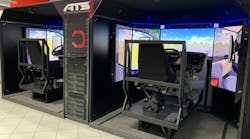The trucking industry needs drivers, and several schools are trying to introduce professional driving as a career to students before they leave high school. Although interstate driving opportunities are limited to those 21 and older, there are options for younger drivers to gain experience.
“We have an aging generation of drivers who are retiring, so we’re looking to the young people to attract them into the industry,” said John Kearney, founder of Advanced Training Systems.
Tooele Technical College in Tooele, Utah, is starting to focus on students between 16-18 years old, said Kim Rice, placement specialist for the school. “Our instructor tells the story of when he was in high school, he would see a truck going down the road and wonder where it was going. We don’t know if young people are thinking that anymore. We hope to entice them,” she said.
One way Tooele Tech reaches youths is through summer camps. The school has a diesel technician camp for seventh and eighth graders, and it is considering a day camp for juniors and seniors interested in driving. The camp would cover pre-trip inspections, place students in simulators so they could learn double-clutch driving, and possibly allow them on the backing range. “We’re trying to get them as young as possible and get them to think of it,” Rice said.
Western Technical College, based in El Paso, Texas, reaches out to students as early as seventh or eighth grade to introduce them to opportunities in trucking. The school also has a high school liaison that goes and does presentations at local and out-of-town high schools. “He covers all our programs and potential career opportunities with each,” said Lynda Cervantes, director of marketing.
J-Tech Institute in Jacksonville, Fla., has an outreach team that works with local high schools. “We talk about life after high school,” he said. “If you think about the high school student, when they walk across that stage, they are forced out and they have to do something.”
Celeste Turner, manager of Hawkeye Community College’s Regional Transportation and Training Center in Waterloo, Iowa, said college officials attend career fairs in the community and at area high schools. Staff encourages students to think of getting a CDL, even if driving isn’t part of their long-term plan.
“We like to explain to the students that even if they plan to attend a two-year or four-year college, they can get their CDL without having a career as a truck driver. The CDL is a tool that they can fall back on or use it as a way to earn income on the weekends, during spring break, etc., to help pay for school,” she said. “Working as a truck driver, they will earn so much more than many jobs college students have.”
The investment-to-income ratio is exponential for drivers, explained Jeff Harris, director of admissions for J-Tech Institute, which costs $4,700 for the CDL program. He said J-Tech partners with the carrier CRST International, which will pay for students’ training if they sign a 10-month contract with the company.
Kearney said technology, such as video cameras that replace mirrors, can help attract new drivers. “Those kinds of advances are going to draw more and more people into the industry and make trucks safer,” he said, adding that high-tech training methods can also attract newcomers. “There will be people who don’t even come into this field because they don’t know about the training opportunities that exist.”
Computer-based learning and simulators resonate with students. Simulators can help take away fear, reduce the total time needed for training and allow schools to train for situations they can’t replicate on the road, such as black ice, a front-tire blowout, wind blowing over a truck or a turn at an excessive speed, Kearney said.
Turner said Hawkeye has four simulators that accelerate student learning in a safe, controlled and non-intimidating environment. “Students learn controls and basic maneuvering, as well as shifting before moving to the actual truck. The simulators help to keep our costs down by reducing the wear and tear on transmissions and driveshafts as well as fuel costs,” Turner said.
Kearney said ATS’s simulators have the real seat and steering wheel of a Class 8 tractor. “Because it is so realistic in the sense of the emotion you’d feel in a real truck, you learn muscle memory,” he said.
Despite the efforts of schools to appeal to younger students, most students in CDL programs are well out of high school. Harris said a lot of candidates transition to driving from construction, warehouse or landscaping jobs.
Turner said more than 70% of the school’s students are between 30-60 years old, with the median age being 40. “There is a high demand for truck drivers, and it has become a second career for many,” she said.
The average student entering Western Tech is older than 28. Cervantes said most of the school’s students have been working in a field and decided to switch careers because the pay is better than where they were. “I don’t think there are many 18- to 20-year-olds that come in and say they want to drive trucks for a living. At 21, I think they have something else in mind,” he said.
Schools are seeing an increase in the number of minorities, women and veterans entering their programs. Nearly 14% of Hawkeye’s students are women, and almost 60% indicate race or ethnicity as non-white, Turner said.
Attracting more women would help ease the driver shortage, and Kearney said new technology and safety equipment could appeal to them. “We need to attract females, so they understand this is a different business than it was years ago,” he said, adding that increased use of automatic transmissions has gotten rid of one of the major complications for training women.
Turner said there are a good number of military veterans attending Hawkeye. “Hawkeye received a Department of Transportation grant called ‘Trucking with the Troops’ that covers the tuition for veterans and their spouses and dependent children,” Turner said. Hawkeye also has a CDL apprenticeship program with Ruan Transportation that also attracts veterans.
Cervantes said a lot of Western Tech’s students get their CDL and drive in the oil field rather than over the road. She said there are also several trucking-related jobs for those under 21 in maintenance.
Drivers can also work in terminals, local delivery routes, truck operators or cement mixer drivers, Rice said. Tooele Tech does provide job placement for those under 21, but said it is more difficult. She added that insurance rates for younger graduates can be costly. “It is more expensive for them to hire younger drivers, but they do it because they are desperate,” she said.
For 19- or 20-year-olds to attend J-Tech, they have to have a written letter from an employer saying they’re going to hire them and understand they can’t drive interstate. “The last thing we want to do in any of our programs is train them and then not have them be marketable,” Harris said, adding that those drivers can often find work hauling produce within the state of Florida.
Rice said she encourages people of all ages to consider driving, even if it is just a stepping stone in their career path. “We really try to drive home to our students here, if you’re not sure what you’re doing the technical job is a great place to start. We’re going to train you to do something that is well paying, and you can do that while you decide what you want,” she said.



